Shadow of Infinity hit store shelves less than two weeks ago, and never before have collectors been so eager for new cards! After weeks of hype and lead-in, the Yu-Gi-Oh! GX “Rise of the Sacred Beasts” story arc is in full swing, and all the excitement and thrills have built an incredible demand for Shadow of Infinity’s three Sacred Beast cards. They’re huge and imposing, and pulling one from a booster can inspire envy in even the most hardened veteran duelist . . .
. . . but are they playable?
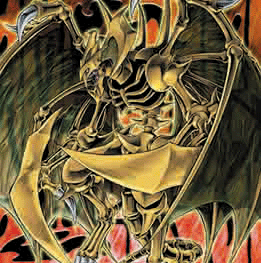 Today’s submitter, Cliff M., has tried to answer that question. While many duelists have attempted to run a deck focusing on Raviel, Lord of Phantasms, Hamon, Lord of Striking Thunder, or Uria, Lord of Searing Flames, Cliff has gone all-out and tried to use all three at once. Here’s what he has to say about his creation:
Today’s submitter, Cliff M., has tried to answer that question. While many duelists have attempted to run a deck focusing on Raviel, Lord of Phantasms, Hamon, Lord of Striking Thunder, or Uria, Lord of Searing Flames, Cliff has gone all-out and tried to use all three at once. Here’s what he has to say about his creation:
Hi Jason,
I must say that I really liked your last article on Rusty Toolbox. I had never thought to use Gearfried the Iron Knight with Blast with Chain. How that managed to slip my mind, I will never know. Probably because I was too concerned with other deck types, what with the release of Shadow of Infinity.
Speaking of which, I've been working on two different types of decks: Cyber Dragons and Sacred Beasts. I already have a good Cyber Dragon deck, so I'll ask you to look at my Sacred Beasts formula.
The deck's basic design is to ward off attacks until you can get all three of the Sacred Beasts on the field, while you draw cards and set things up in the meantime. I've managed to get out Raviel and Uria during playtesting at least once or twice, but never had the courage to summon Hamon during the given situations (face-down cards left and right, no Uria to help out). Perhaps you could have a look at this deck and fix it up so that it flows better?
Cliff M., Dalton, GA
Ambitious! From Cliff’s comments, you might already be spotting some realities of his situation. That said, my goal will be to preserve his intent as much as is reasonably possible. Here’s the decklist that Cliff sent to me.
The Sacred Beasts Arise!
42 Cards
Monsters: 18
1 Uria, Lord of Searing Flames
1 Hamon, Lord of Striking Thunder
1 Raviel, Lord of Phantasms
2 Dark Necrofear
3 Dark Mimic LV1
2 Big Eye
1 Cyber Jar
1 Magician of Faith
1 Sangan
1 Slate Warrior
1 Goblin Elite Attack Force
3 Giant Germ
Spells: 15
1 Pot of Avarice
3 Magical Mallet
3 Messenger of Peace
1 Dark Hole
1 Heavy Storm
3 7
2 Giant Trunade
1 Premature Burial
Traps: 9
1 Call of the Haunted
2 Embodiment of Apophis
2 Royal Decree
3 Sakuretsu Armor
1 Return from the Different Dimension
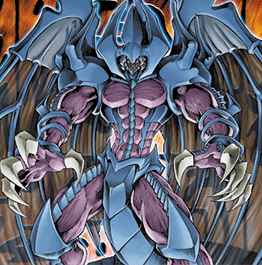 Looking at Cliff’s decklist, you can clearly see that he’s working with three different themes and trying to juggle each one. Slate Warrior, Goblin Elite Attack Force, Dark Mimic LV1, and several other monsters are Fiends, acting as tribute fodder for the summoning requirement of Raviel, Lord of Phantasms. Giant Germ and Dark Necrofear are especially synergistic, since they can overcome the restriction of one normal summon per turn that often makes amassing three Fiends on the field such a challenge. Messenger of Peace and 7 serve to fulfill the requirements for Hamon, Lord of Striking Thunder, and Embodiment of Apophis and Royal Decree support Uria, Lord of Searing Flames.
Looking at Cliff’s decklist, you can clearly see that he’s working with three different themes and trying to juggle each one. Slate Warrior, Goblin Elite Attack Force, Dark Mimic LV1, and several other monsters are Fiends, acting as tribute fodder for the summoning requirement of Raviel, Lord of Phantasms. Giant Germ and Dark Necrofear are especially synergistic, since they can overcome the restriction of one normal summon per turn that often makes amassing three Fiends on the field such a challenge. Messenger of Peace and 7 serve to fulfill the requirements for Hamon, Lord of Striking Thunder, and Embodiment of Apophis and Royal Decree support Uria, Lord of Searing Flames.
We have an immediate problem. While Raviel, Lord of Phantasms is backed up by over a dozen monsters that can fulfill its tribute requirement, Hamon and Uria have received significantly less support. Hamon only has 7 and Messenger of Peace to draw from—a total of six cards. Uria has even less of a chance of coming into play, since Cliff is only running a pair each of Royal Decree and Embodiment of Apophis, as well as one copy of Call of the Haunted. The chance of being able to draw into either Uria or Hamon at the right time, as well as three of their very limited support cards, is incredibly low. Add to that the fact that Mystical Space Typhoon or Dust Tornado can destroy one continuous spell or trap and ruin your ability to summon one of the Sacred Beasts, and you’ve got some serious, serious issues.
Most duelists currently trying to run the Sacred Beasts are focusing on multiple copies of just one of them. Decks focused around Hamon, Uria, or Raviel individually can devote themselves to doing little but fulfilling their Beast’s summoning requirement, and can thus ensure that they can bring out that Beast on a reliable basis. None of the Sacred Beasts are easy to play. All three of them usually fasten the hopes of four cards onto one, and the Beasts themselves will often sit in your hand acting as a dead draw in the early game. Unlike other combo decks, such as Last Turn or Return from the Different Dimension, you can’t even use the dead cards that the deck will give you as bluffs. The Beasts are monsters, and you can’t set them in the spell and trap zone, making them a dangerous burden sometimes.
However, there’s plenty of hope. We can minimize that potential burden and ensure success by narrowing this deck’s focus. Cliff’s goal is to play multiple Sacred Beasts, which makes his strategy very different from that of most duelists experimenting with these cards. I want to preserve Cliff’s goal, but at the same time, it’s impossible to run all three Beasts in one stack of forty some-odd cards. I’m going to cut one of the Sacred Beasts from the deck and work with just a pair.
Raviel, Lord of Phantasms is, in my opinion, the auto-include out of the three. Giant Germ and Dark Necrofear give a powerful basis for supporting Raviel, since each can be special summoned, and Cliff has laid down solid groundwork by using them. I think he’s done work there that’s worth keeping, and it’ll determine the direction for the rest of the deck.
From here, I need to drop either Hamon, Lord of Striking Thunder or Uria, Lord of Searing Flames. In all honesty, I’m not thrilled with many of the choices that Cliff made when selecting continuous traps and spells. Messenger of Peace is a good choice for Hamon, but 7 is beyond weak. Embodiment of Apophis is cool, but Royal Decree in a deck with nine trap cards is going to come back to haunt you eventually.
I don’t really have a compelling case in either Hamon or Uria’s favor when it comes to the pre-existing infrastructure of the deck. I’m going to have to go on raw potential.
Hamon’s pair of effects dish out extra damage when it destroys a monster, and they allow it to act as a wall so long as nothing destroys it through an effect. Unfortunately, Smashing Ground has never been more popular. Hamon’s big, and it can ram damage through things it destroys even if the opponent is hiding behind a bunch of defensive cards, but I’m not sure that it stacks up to . . .
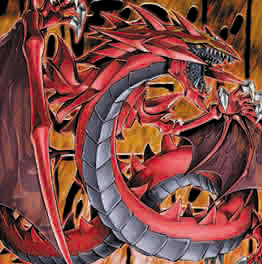 . . . the amazing Uria, Lord of Searing Flames! The downside to Uria is that it’s the only Sacred Beast that isn’t packing an automatic 4000 ATK and 4000 DEF. Its stats are based on the number of continuous traps in your graveyard, but that can actually work in your favor.
. . . the amazing Uria, Lord of Searing Flames! The downside to Uria is that it’s the only Sacred Beast that isn’t packing an automatic 4000 ATK and 4000 DEF. Its stats are based on the number of continuous traps in your graveyard, but that can actually work in your favor.
The really cool part is that Uria can destroy a card in the opponent’s spell and trap zone once per turn. And the opponent can’t chain it. It just blows up. No shenanigans with Dust Tornado or Ceasefire. Just a resounding “boom,” and then card advantage for you. Uria is the one Sacred Beast that can start redeeming the investment you make from the moment it hits the table. For that reason alone, I’d pick it over Hamon.
But wait! There’s more! Embodiment of Apophis not only acts as fodder for Uria’s summoning, but it can also make a fast tribute for Raviel’s effect, bumping up its ATK value. When you’re looking to capitalize on a single attack position monster like Magician of Faith or Magical Merchant, every consolidated point of ATK value counts, and Embodiment of Apophis has nice synergy with both Raviel and Uria.
It’s a no-brainer. While I feel a little bad for having to wield the Cold Fist of Reality, this deck needs to go down to two Sacred Beasts in order to survive. Uria and Raviel are the perfect running mates, so I’m going to take the deck in that direction.
With that said, here come some drops! If Hamon is gone, then we can safely rid the deck of 7 and Messenger of Peace. We’ll use those slots for more copies of continuous traps, which will make Uria easier to summon.
The only monsters I want to drop are Hamon and the pair of Big Eyes. I don’t think my fixed version of this deck will be so desperate to get to its Sacred Beasts on a rigid schedule, and it’s going to have a lot more stall power anyway. Not only will I drop both copies of Big Eye, I’m also going to remove Magical Mallet from the deck. This isn’t a deck like Cyber-Stein One-Turn Kill, and it doesn’t need its primary combos to win. Magical Mallet is a great card for several strategies, but I don’t feel like it’s quite right here.
Uria has the ability to protect itself from cards like Bottomless Trap Hole and Torrential Tribute. So long as it uses its effect with priority once it hits the field, it’s safe from cards that would destroy it at the point of summoning. From there, both Uria and Raviel are vulnerable to Sakuretsu Armor or Widespread Ruin. Cliff has used Giant Trunade to try and play around this problem, but again, I feel that makes the deck too focused on claiming a win through a Sacred Beast while debilitating its performance when it draws poorly. Both copies of Giant Trunade will be bounced to the side deck.
You’ve already heard my thoughts on playing Royal Decree in a deck that’s packed with traps, and thanks to our use of Uria, this deck is only going to get heavier in the fuchsia department. Both copies of Royal Decree will be dropped. With Decree and Giant Trunade removed, Cliff will need to be more careful about when he attacks. That’s not asking a lot, though, and the deck will be far more consistent without the conditional cards that were holding it back.
Speaking of which, I’m a bit confused as to what Return from the Different Dimension is doing in this deck. Yes, Dark Necrofear can remove Fiend monsters from your graveyard. But that’s probably only going to happen once per game, meaning that Return will almost never bring more than three monsters to the field. In many cases, at least one of those monsters will be a lightweight, like Dark Mimic LV1 or Giant Germ. On top of that, this deck does nothing to establish the aggressive tempo that Return from the Different Dimension needs in order to be a game-breaking card. It doesn’t make much sense here, so the one copy of Return will be my final drop from the decklist.
On to some additions! With three monsters gone, we can afford to add a few more. I want to replace the two Fiends I lost in the form of Big Eye, so I’m going to build on the groundwork that Cliff has already laid down. I’ll add one more Slate Warrior and one more Goblin Elite Attack Force. Slate Warrior can be a great answer to Mobius the Frost Monarch or Cyber Dragon, and Goblin Elite takes down the Dragon as well.
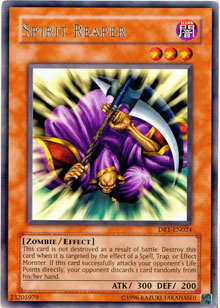 I’m going to add a pair of Spirit Reapers, too. Without them, this deck is a bit low on good opening plays for those duels where you go first. Spirit Reaper is a superior wall, a great way to net card advantage, and a must-play card in any deck that can benefit from either of its effects. If you ever overextend with a Sacred Beast and things go awry, Spirit Reaper will be able to buy you the time you need to recover.
I’m going to add a pair of Spirit Reapers, too. Without them, this deck is a bit low on good opening plays for those duels where you go first. Spirit Reaper is a superior wall, a great way to net card advantage, and a must-play card in any deck that can benefit from either of its effects. If you ever overextend with a Sacred Beast and things go awry, Spirit Reaper will be able to buy you the time you need to recover.
Moving on to spells, I want to load the deck with some standard entries that it just didn’t have space for before. Snatch Steal, Mystical Space Typhoon, and Nobleman of Crossout are all pretty much staples for battle-oriented decks. (I don’t toss the term “staple” around very often, but I really can’t think of any battle-oriented deck that couldn’t benefit from these three cards.)
On top of that, two Smashing Grounds will help keep the field under control, and ensure that Uria or Raviel can attack directly when they hit the field. When we’re on the defensive, Smashing Ground will keep the opponent’s monster count down. When we’re on the offensive, it’ll clear out monsters like Spirit Reaper and D. D. Assailant, allowing us another degree of safety for Uria and Raviel.
The last spell I want to add to the deck is Swords of Revealing Light. Again, like Spirit Reaper, this card will act as a fallback in those situations where a Sacred Beast falls to an opponent’s monster destruction. However, also like Spirit Reaper, Swords of Revealing Light will do more than stall us out of a bad situation. It will also provide an easy way to maintain field presence, making the task of summoning Raviel, Lord of Phantasms a bit easier.
Finally, I want to add some additional continuous traps to our arsenal. More continuous traps will make it a lot easier to summon Uria, Lord of Searing Flames. Plus, any continuous traps that get sent to the graveyard will end up working in our favor later on in the game, because they’ll form the basis for Uria’s ATK and DEF values.
I really like Embodiment of Apophis in this deck. Whether it’s bringing us one step closer to summoning Uria, feeding Raviel’s effect, or just acting as a normal blocker or attacker, the Embodiment is going to be versatile and have a lot of utility. It’s a great way to pump up Uria’s stats, and it can quickly create situations in which your monsters outnumber the opponent’s. I’m going to add a third copy to the deck.
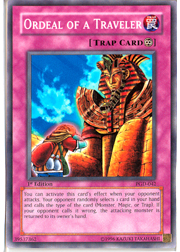 Then, I’ll add two copies of Gravity Bind and two copies of Ordeal of a Traveler. Both of these cards deter attacks, but they do so in very different ways. Gravity Bind will lock down the entire field, including your monsters. It’s a heavy, effective defense card, but it will also stunt our offense. Ordeal of a Traveler is more flexible—it’ll cause problems for the opponent while still allowing us to attack. However, Ordeal’s lock on the field isn’t nearly as effective as Gravity Bind’s, so be aware that it won’t always be reliable. Remember to manage your hand carefully. You need to ensure that your opponent can’t use the knowledge that he or she might have gained from previous attacks to circumvent the Ordeal’s effect on future turns. However, with a bit of luck and some wit on your behalf, Ordeal of a Traveler can be one of the most damaging cards in the format. While it won’t provide card advantage, it will provide monster advantage, and that’s the key to winning in the current Advanced environment.
Then, I’ll add two copies of Gravity Bind and two copies of Ordeal of a Traveler. Both of these cards deter attacks, but they do so in very different ways. Gravity Bind will lock down the entire field, including your monsters. It’s a heavy, effective defense card, but it will also stunt our offense. Ordeal of a Traveler is more flexible—it’ll cause problems for the opponent while still allowing us to attack. However, Ordeal’s lock on the field isn’t nearly as effective as Gravity Bind’s, so be aware that it won’t always be reliable. Remember to manage your hand carefully. You need to ensure that your opponent can’t use the knowledge that he or she might have gained from previous attacks to circumvent the Ordeal’s effect on future turns. However, with a bit of luck and some wit on your behalf, Ordeal of a Traveler can be one of the most damaging cards in the format. While it won’t provide card advantage, it will provide monster advantage, and that’s the key to winning in the current Advanced environment.
Finally, I want to add one copy of Skull Lair to the deck. Again, I’m looking for splashable continuous traps, and this one is going to combine nicely with Giant Germ. It’s another answer to Spirit Reaper, and it’s a great way to defend your set monsters (like Slate Warrior and Dark Mimic LV1) from Mystic Swordsman LV2. In fact, it’s quite possible that Skull Lair may see an upswing in play over the next few weeks. With so many duelists playing Flip-Flop Control variants in the wake of Shonen Jump Durham, Mystic Swordsman LV2 is huge, and Skull Lair is a superb retort to the little fellow’s homicidal advances.
Here are the changes I wound up making to Cliff’s deck.
-1 Hamon, Lord of Striking Thunder
-2 Big Eye
-3 7
-3 Messenger of Peace
-2 Giant Trunade
-3 Magical Mallet
-2 Royal Decree
-1 Return from the Different Dimension
+1 Slate Warrior
+1 Goblin Elite Attack Force
+2 Spirit Reaper
+1 Snatch Steal
+1 Mystical Space Typhoon
+1 Nobleman of Crossout
+2 Smashing Ground
+1 Swords of Revealing Light
+2 Gravity Bind
+2 Ordeal of a Traveler
+1 Embodiment of Apophis
+1 Skull Lair
The final fixed version is as follows.
The Sacred Beasts Arise!: Jason’s Fix
41 Cards
Monsters: 19
1 Uria, Lord of Searing Flames
1 Raviel, Lord of Phantasms
2 Dark Necrofear
3 Dark Mimic LV1
1 Cyber Jar
1 Magician of Faith
1 Sangan
2 Slate Warrior
2 Goblin Elite Attack Force
3 Giant Germ
2 Spirit Reaper
Spells: 10
1 Pot of Avarice
1 Dark Hole
1 Heavy Storm
1 Premature Burial
1 Snatch Steal
1 Mystical Space Typhoon
1 Nobleman of Crossout
2 Smashing Ground
1 Swords of Revealing Light
Traps: 12
1 Call of the Haunted
3 Embodiment of Apophis
3 Sakuretsu Armor
2 Gravity Bind
2 Ordeal of a Traveler
1 Skull Lair
 What we have here is basically a Fiend deck with some interesting twists. It’s definitely packing everything that the standard Fiend deck would have. Giant Germ, Slate Warrior, and Goblin Elites serve to control the field through their own presence. Dark Mimic LV1 manipulates tempo and loads the graveyard with Fiends for Dark Necrofear. The Necrofear itself will frequently act as your win condition, swooping in to deal damage at an unexpected time or stealing away your opponent’s monster.
What we have here is basically a Fiend deck with some interesting twists. It’s definitely packing everything that the standard Fiend deck would have. Giant Germ, Slate Warrior, and Goblin Elites serve to control the field through their own presence. Dark Mimic LV1 manipulates tempo and loads the graveyard with Fiends for Dark Necrofear. The Necrofear itself will frequently act as your win condition, swooping in to deal damage at an unexpected time or stealing away your opponent’s monster.
Necrofear deserves some serious attention in this format, and it hasn’t received much yet. Even if it gets run over the moment it hits the field, once it grabs the opponent’s monster it can easily generate card advantage. If you manage to swipe a decent attacker from the opponent and attack with it, your opponent either has to lose a monster, use a card like Sakuretsu Armor, or let the attack hit him or her directly. If your opponent loses a monster or uses a spell or trap, you’ve gained card advantage, since he or she is basically destroying his or her own card. And if you attack directly? Well, damage is damage, and dishing it out is always a good thing. Those are good deals all around.
The differences between this and a standard Fiend deck are obviously the pair of Sacred Beasts and the plethora of continuous traps. The Beasts aren’t as complicated as one might think. Basically, each card offers you a reason to over-commit to the field. Heavy field commitments are becoming more and more popular, due to the slow tempo that many duelists have adopted, so this is actually a pretty great time to play with the Sacred Beasts. It won’t be uncommon for both players to have three monsters or three back-row cards on the field anyway, so instead of fearing Dark Hole or Heavy Storm, you can slowly build the field presence that Uria and Raviel crave.
The big complication is the trap engine. You’ve got a lot of tricky cards that most players aren’t familiar with, and they change how the deck naturally wants to be played. In essence, all of your continuous traps are oriented around field control, and each works within a different context to disrupt the opponent. As previously mentioned, Gravity Bind freezes the field for both you and your opponent. Be careful when using it, but remember that it’s your best answer to general aggression. It works well in the early, mid-, and late game, so it’s flexible in that respect. Ordeal of a Traveler is one step down in efficiency, since it won’t provide absolute control, but it will permit your monsters to attack as normal. It’s more of an early and mid-game card, since you need to have a couple of cards in your hand for it to work properly. Skull Lair is very similar in some ways, providing partial protection against potential attackers. However, unlike Ordeal, the Lair kicks increasing amounts of behind as the game progresses. With a nice pile of monsters in the graveyard, it can wipe the field clean in an instant.
And of course, Embodiment of Apophis is just all-around good. It can act as a defender to shut down Spirit Reaper or Don Zaloog, or it can put its back into an attack. It’s one of the trickier cards to use in this deck since it can do so much, so experiment with it in different situations and figure out how it works best for you.
This deck will basically perform like a middle-of-the-road beatdown with some tempo control thrown in. It wants to open with Giant Germ, Spirit Reaper, or Sangan. In fact, Sangan can even search for Uria! From there it’s a balanced deck in the early, mid-, and late games. It can topdeck pretty well thanks to Goblin Elite Attack Force, Slate Warrior, and Dark Necrofear, and it’s pretty strong in any situation one can foresee. It’s not particularly good at any individual point in the game, but it makes up for that fact by being able to drop Raviel and Uria at pretty much any time.
Your overall goal should be to keep the field as clear as possible and build a monster presence, either for battle or for the summoning of Raviel. Play the deck like a clever beatdown with plenty of field control—you’ll often win games without even seeing one of your Sacred Beasts. When a Beast does arrive in your hand, though, take some time to make the opponent waste some of his or her Sakuretsu Armors and Smashing Grounds before summoning it. Doing so shouldn’t be very difficult, because you’ve got plenty of big attackers that the opponent will want to destroy. You don’t need to have big card advantage and absolute control over the game before dropping a Beast, just be careful of monster destruction. In fact, you might even want to side deck a pair of My Body as a Shield cards for particularly controlling opponents.
That’s it! A completely viable, dual Sacred Beast deck. If you’ve managed to open or trade for a few of these guys and are itching to let them see some table time, try this deck out. It’s based on solid, proven theories of field control as well as Fiend mechanics, and will perform reliably once you get some practice with it. It’s a challenge to play, but it can be very rewarding. Honestly, I don’t care how hardcore you are. Don’t you want to summon a Sacred Beast and attack to win the game at least once in your Yu-Gi-Oh! TCG career? This deck can make it happen!
—Jason Grabher-Meyer
Do you have an Advanced format deck you could use some help with, or that you just want to show off to the world? Do you want to see it appear in a future Apotheosis article? Send it to me at Jason(at)metagame(dot)com, with your name, location, and explanation of how the deck works—I might take a crack at it!